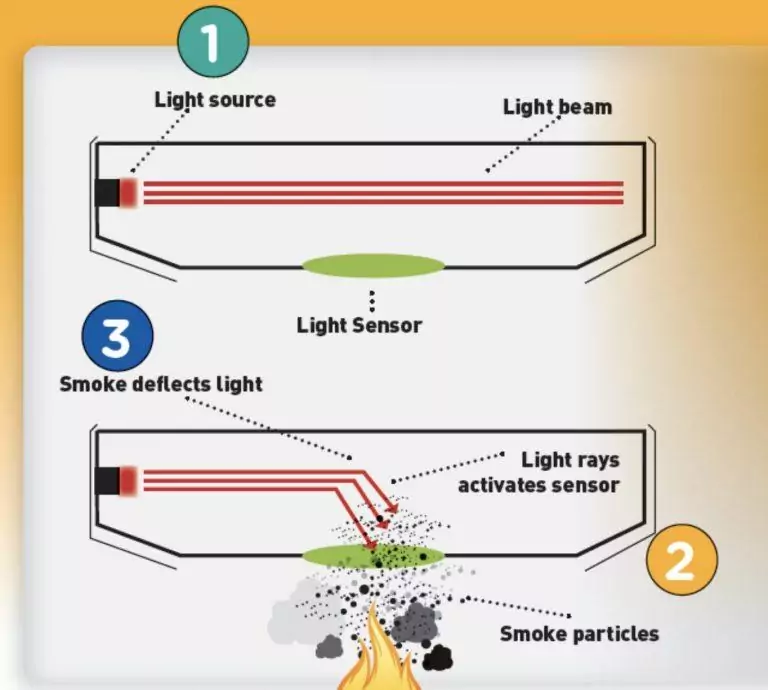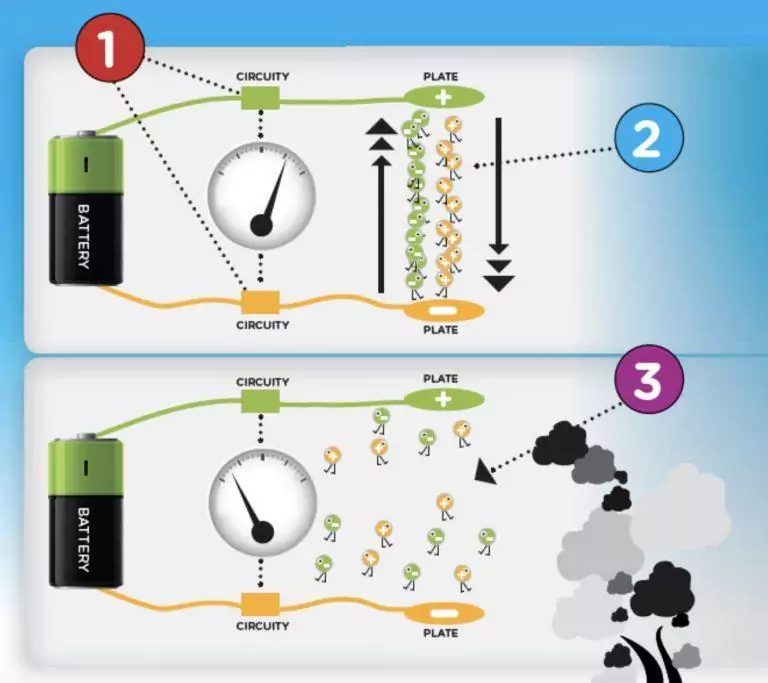Choosing the right smoke alarm can mean the difference between precious seconds and a safe escape during a fire. Two prevalent types, photoelectric smoke detectors and ionization smoke detectors, offer distinct advantages.
But which alarm reigns supreme? Is photoelectric better than ionization or vice versa?
This guide dives deep into the key differences between photoelectric and ionization smoke detectors to help you decide. We’ll explore their inner workings and fire responsibilities to empower you with the knowledge to make an informed decision
Photoelectric Vs Ionization Smoke Detector: An Overview
Here’s a comparison table outlining the main differences between these two smoke detectors:
| Features | Photoelectric Smoke Detector | Ionization Smoke Detector |
| Detection Principle | Relies on light scattering | Relies on ionization |
| Detection Speed | Slower response to smoldering fires | Faster response to flaming fires |
| Sensitivity | Highly sensitive to large smoke particles | Highly sensitive to small smoke particles |
| False Alarm Potential | Less prone to false alarms | More prone to false alarms |
| Types of Fires Detected | Better at detecting smoldering fires, such as those caused by overheated wiring or slow-burning fires | Better at detecting flaming fires, such as those caused by burning paper or flammable liquids |
| Interference | Less susceptible to interference from steam or cooking fumes | More susceptible to interference from steam or cooking fumes |
| Environmental Impact | Generally considered more environmentally friendly, as they don’t contain radioactive materials | Contains a small amount of radioactive material, Americium-241 |
| Price | Typically more expensive | Generally more affordable |
| Common Applications | Residential settings, bedrooms, living rooms | Commercial buildings, kitchens, garages |
As you can see, there’s no single “better” choice between photoelectric and ionization smoke detectors. They both have strengths and weaknesses. Ultimately, the best approach for maximum protection is to install both types of detectors throughout your home, which is recommended by the National Fire Protection Association (NFPA).
The rest of this guide will dive deeper into the topic of photoelectric and ionization smoke alarms so you can fully understand their differences and similarities.
What Is Photoelectric Smoke Detector?
A photoelectric smoke detector is a type of smoke detector that operates on the principle of light scattering. It consists of a light source (usually an infrared LED) and a photosensitive sensor.

When smoke enters the detection chamber, it scatters the light emitted by the source, causing it to strike the sensor. This triggers the alarm as the sensor detects the scattered light.
Photoelectric smoke detectors are particularly effective at detecting smoldering fires, such as those caused by overheated wiring or slow-burning fires. They are less prone to false alarms and are often used in residential settings.
Some of the bets photoelectric smoke detectors are:
- Kidde Hardwired Photoelectric Smoke Detector
- X-Sense Battery Photoelecric Smoke Detector
- First Alerts Battery Photoelectric Smoke Detector
What Is an Ionization Smoke Detector?
An ionization smoke detector is an alarm that uses electrically charged particles, called ions, to detect smoke in the air. It contains a small radioactive material, typically Americium-241, which emits alpha particles.

The smoke detector consists of two charged plates and a radioactive source. When smoke particles enter the detection chamber, they disrupt the electrical current between the plates, triggering the alarm.
Ionization smoke detectors are highly sensitive to small smoke particles and are more responsive to flaming fires, such as those caused by burning paper or flammable liquids. However, they are more prone to false alarms and are commonly found in commercial buildings, kitchens, and garages.
Some of the best Ionization smoke detectors are:
- Kidde Hardwired Ionization Smoke Detector
- First Alert Battery Ionization Smoke Detector
- Kidde Battery Ionization Smoke Detector
What Are The Main Differences Between Photoelectric and Ionization Smoke Detectors?
The main differences between photoelectric smoke detectors and ionization smoke detectors lie in their detection principles, response to different types of fires, sensitivity to smoke particles, susceptibility to false alarms, and environmental impact.
Here is a detailed overview of these differences:
Detection Principle
Photoelectric smoke detectors rely on the principle of light scattering. They emit a beam of light and when smoke enters the detection chamber, it scatters the light, triggering the alarm.
On the other hand, ionization smoke detectors operate based on ionization. They use a small amount of radioactive material to create a steady electrical current between two charged plates. When smoke particles disrupt this current, the alarm is activated.
Response to Different Types of Fires
Photoelectric smoke detectors excel in detecting smoldering fires, which produce more visible smoke and less heat. These types of fires are often caused by overheated wiring or slow-burning materials.
Ionization smoke detectors, on the other hand, are more responsive to flaming fires that produce a significant amount of heat and less visible smoke. These fires are typically caused by burning paper, flammable liquids, or other rapidly combusting materials.
Sensitivity to Smoke Particles
Photoelectric smoke detectors are highly sensitive to large smoke particles that are typically produced during the early stages of a fire. They can quickly detect the presence of smoldering fires and provide an early warning.
In contrast, ionization smoke detectors are highly sensitive to small smoke particles that are generated by fast-burning, flaming fires. They are designed to quickly respond to rapidly developing fires.
Susceptibility to False Alarms
Photoelectric smoke detectors are generally less prone to false alarms compared to ionization smoke detectors. Photoelectric detectors are less likely to be triggered by non-fire-related sources such as cooking fumes or steam from hot showers, reducing the incidence of false alarms.
Ionization smoke detectors, due to their sensitivity to small particles, are more susceptible to false alarms caused by these non-fire-related sources.
(See this related guide about smoke detectors going off randomly for no apparent reason, and how to fix it, for more details on this topic.)
Environmental Impact
Photoelectric smoke detectors are considered more environmentally friendly as they do not contain radioactive materials. On the other hand, ionization smoke detectors use a small amount of radioactive material, Americium-241, for their ionization process.
While the amount of radioactive material is minimal and deemed safe for regular use, it is still a factor to consider in terms of environmental impact.
Which Smoke Alarm Is Better?
Determining which smoke alarm is the better, whether a photoelectric smoke detector or an ionization smoke detector, depends on the specific requirements and priorities of the user.
Both types have their strengths and weaknesses, so the choice ultimately depends on individual needs. However, considering the following factors, the photoelectric smoke detector may be the better option in many scenarios:
1. Detection of Smoldering Fires
Photoelectric smoke detectors excel at detecting smoldering fires, which produce larger smoke particles and are typically slower burning. This is a critical advantage as smoldering fires can often smolder undetected for extended periods before erupting into flames. By providing early detection, photoelectric detectors offer more time for evacuation and response, enhancing overall safety.
2. Reduced False Alarms
Photoelectric smoke detectors are generally less prone to false alarms caused by non-fire-related sources such as cooking fumes or steam. This is due to their focus on detecting larger smoke particles associated with actual fires. By minimizing false alarms, the photoelectric detectors prevent unnecessary panic, alarm fatigue, and potential disregard for alarms.
3. Environmental Impact
Photoelectric smoke detectors are considered more environmentally friendly as they do not contain any radioactive materials. In contrast, ionization smoke detectors use a small amount of radioactive material (Americium-241) to facilitate their ionization process.
While the radioactive materials in ionization detectors are generally safe in normal use, the absence of such materials in photoelectric detectors eliminates any associated concerns.
4. Regulatory Trends
In recent years, there has been a growing preference for photoelectric smoke detectors due to their improved performance in detecting smoldering fires and reduced false alarms. Several jurisdictions have updated their building codes and regulations to reflect this preference. Therefore, choosing a photoelectric smoke detector over an ionization alarm ensures compliance with current and future regulations, providing peace of mind.
5. Comprehensive Coverage
While the photoelectric smoke detector is generally considered the better option, it’s important to note that both types of smoke alarms have their merits.
For optimal fire detection, it is recommended to have a combination of both photoelectric and ionization smoke detectors or utilize dual-sensor smoke detectors that incorporate both technologies.
This fire safety strategy allows for a balanced approach, leveraging the strengths of each type to cover a wider range of fire types and minimize their respective limitations.
Which Smoke Alarm Has A Good Lifespan?
Both photoelectric smoke detectors and ionization smoke detectors generally have similar lifespans, which typically range from 8 to 10 years. However, the lifespan of a smoke alarm can vary depending on factors such as the quality of the device, environmental conditions, and regular maintenance.
It’s important to note that while the lifespan of the smoke alarm is important, it’s equally crucial to regularly test and maintain the device to ensure its proper functioning throughout its lifespan. This includes testing the alarm regularly, replacing batteries as needed, and cleaning the smoke alarm to remove any dust or debris that could affect its performance.
By following the manufacturer’s guidelines and practicing regular maintenance, you can maximize the lifespan and reliability of any smoke alarm you choose (photoelectric or ionization).
Conclusion
When it comes to prioritizing safety, there’s a lot of debate between installing a photoelectric smoke detector vs ionization smoke detector. However, in many cases, the photoelectric smoke detector emerges as the preferred choice. Its ability to effectively detect smoldering fires, reduce false alarms, and eliminate the use of radioactive materials makes it a reliable and environmentally friendly option for most people.
